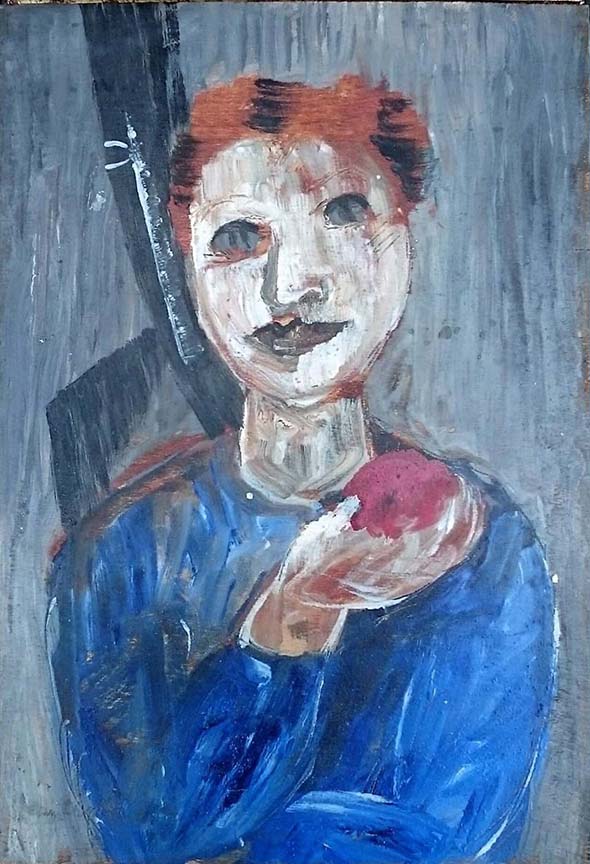

JEAN CROTTI
"ARLEQUIN"
ETCHING, SIGNED
FRANCE, DATED 1928, NUMBER 25/60
EDITION JACQUES VILLON
17.5 X 12.5 INCHES
Jean Crotti 1878 – 1958 Crotti was born on 1878 in Bulle near Fribourg in the western, French-speaking section of Switzerland. Crotti’s works were exhibited at the Salon d’Automne and the Salon des Indépendants from 1907-1923. He was also included in the 1925 Exposition Internationale at l’Art d’Aujourd’hui in Paris, and the “International Exhibition of Modern Art” at the Brooklyn Museum organized by the Société Anonyme in 1926-1927. His solo exhibitions since the 1920’s included the Galerie de France of Paris in 1942, the Museo Caccia of Lugano in 1955, the Cordier and Ekstrom Gallery of New York in 1970, the Kunstmuseum Winterthur in 1972, and the Gimpel Fils Gallery of London in 1974 and Hanover in 1974. His early arts education was in Germany and France. He studied at the School of Decorative Arts in Munich and the Académie Julian in Paris. He left school in 1902 in order to detach himself and become independent as an artist. His earliest paintings, from 1900-1908, are quiet domestic scenes reminiscent of Bonnard and Vuillard. His work begins to show the influence of Orphism and Cubism in 1911. To escape from wartime Paris Crotti and his wife, Yvonne, moved to New York City. An article in the New York Tribune, “French Artists Spur on American Art,” (Oct. 24, 1915) interviewed a number of artists, including Marcel Duchamp, Francis Picabia, Albert and Juliette Gleizes, and Jean Crotti, all refugees from the war who looked to America as a place where they could live and develop their art. In New York, Crotti established close friendships with Marcel Duchamp and Francis Picabia, and shared a studio with Duchamp. In 1915 there was a radical change in his work, no doubt the effect of his close working relationship with these artists. He called this moment his, “second birth by auto-procreation and self-delivery without umbilical cord.” The shift in Crotti’s style was represented in the 1916 group exhibition (with Duchamp, Gleizes, and Metzinger) at the Montross Gallery. Crotti exhibited Orphist-like paintings, several of which had religious titles. The first contact between the artists in Zurich and those in New York was a letter sent in September 1916, announcing the activities in Zurich at the Cabaret Voltaire. Crotti returned to Paris in the fall of 1916, leaving his wife in New York. By 1917 his marriage had dissolved and two years later in Paris he married Suzanne Duchamp, the sister of Marcel Duchamp. The artists associated with the Dada movement were not active in Paris during the war. The French avant-garde kept abreast of Dada activities in Zurich due to the efforts of Tristan Tzara, who communicated by exchanging letters, poems, and magazines with Guillaume Appolinaire, Max Jacob, André Breton, and other French writers, critics and artists. The first introduction of Dada to the Parisian public was at the Salon des Indépendants in 1921. Crotti exhibited works associated with Dada together with a work entitled “Explacatif” bearing the word “Tabu.” In February 1921, Crotti tells of a mystical experience, which was partially responsible for his latest transformation in his work. The new direction, which he called “Tabu,” was presented in religious terms, its key concepts being mystery and infinity. “To express the mystery; that which cannot be seen; that which cannot be touched.” Crotti died on January 30, 1958 in Paris. A fine example of this Tabu period, “Mystère Acatène”, was shown at the Los Angeles County Museum of Art in 1986 at the much acclaimed exhibition “The Spiritual in Art: Abstract Painting 1890-1985.”
|